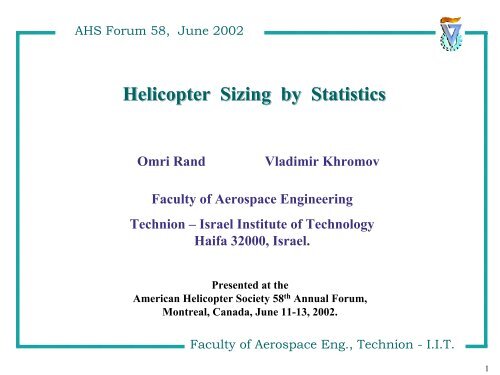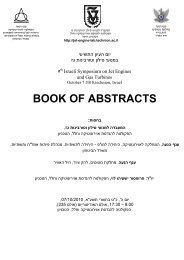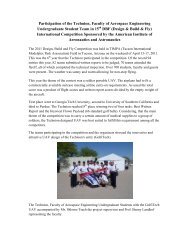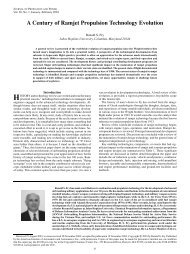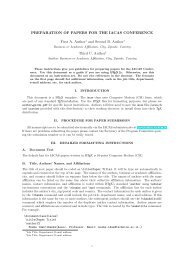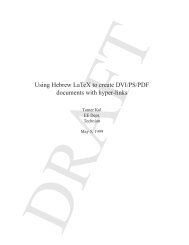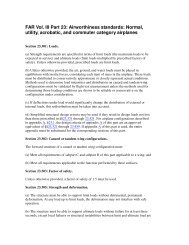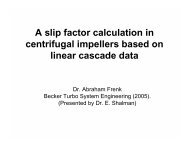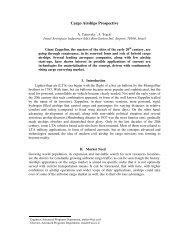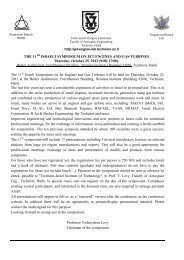Helicopter Sizing by Statistics - Faculty of Aerospace Engineering
Helicopter Sizing by Statistics - Faculty of Aerospace Engineering
Helicopter Sizing by Statistics - Faculty of Aerospace Engineering
You also want an ePaper? Increase the reach of your titles
YUMPU automatically turns print PDFs into web optimized ePapers that Google loves.
AHS Forum 58, June 2002<br />
<strong>Helicopter</strong> <strong>Helicopter</strong> <strong>Sizing</strong> <strong>Sizing</strong> <strong>by</strong> <strong>by</strong> <strong>Statistics</strong><br />
<strong>Statistics</strong><br />
Omri Rand Vladimir Khromov<br />
<strong>Faculty</strong> <strong>of</strong> <strong>Aerospace</strong> <strong>Engineering</strong><br />
Technion – Israel Institute <strong>of</strong> Technology<br />
Haifa 32000, Israel.<br />
Presented at the<br />
American <strong>Helicopter</strong> Society 58 th Annual Forum,<br />
Montreal, Canada, June 11-13, 2002.<br />
<strong>Faculty</strong> <strong>of</strong> <strong>Aerospace</strong> Eng., Technion - I.I.T.<br />
1
AHS Forum 58, June 2002<br />
Introduction<br />
• <strong>Sizing</strong> is the first and an important stage in helicopter preliminary design process.<br />
• Preliminary design tools are relatively simple and were developed for fast design cycles.<br />
• “Design trends” analysis is a well known technique in which flying configurations are<br />
analyzed in order to conclude or identify a trend which is common to many configurations,<br />
and therefore, it may represent physical constrains which are not clear and evident at the early<br />
stages.<br />
• “Design trends” analysis is useful for the sizing stage in its broad sense: geometrical<br />
sizing and preliminary “sizing” <strong>of</strong> performance, power required, etc.<br />
• The present study is based on a (partial) database for more than 180 conventional single<br />
rotor helicopter configurations. The analysis has been carried out using advanced<br />
computerized correlation technique which is based on Multiple Regression Analysis.<br />
<strong>Faculty</strong> <strong>of</strong> <strong>Aerospace</strong> Eng., Technion - I.I.T.<br />
2
AHS Forum 58, June 2002<br />
Multiple Regression Analysis (MRA):<br />
The Analysis Methodology<br />
• A computerized algorithm has been coded to generate and select hundreds <strong>of</strong> combinations <strong>of</strong><br />
independent variables, in order to identify the groups that provide high correlation measure.<br />
• The purpose was to find design trends that contain minimal number <strong>of</strong> independent unknowns<br />
(preferably one or two) that exhibit high correlation indicators.<br />
• Error definition:<br />
Y = a Xα 1 Xβ 2 Xγ<br />
3...<br />
ε (%) = 100<br />
| EV - DBV|<br />
DBV<br />
where EV and DBV stand for the estimated value and the database value, respectively. For each case we<br />
shall present the averaged ε and maximum error obtained, defined <strong>by</strong><br />
AVER ε MAX<br />
1<br />
N<br />
∑<br />
i=<br />
1<br />
AVER MAX<br />
ε = ε and ε = max( ε<br />
N i i<br />
ε i<br />
where N is the number <strong>of</strong> configurations involved, is the error calculated for the i-th configuration.<br />
.<br />
<strong>Faculty</strong> <strong>of</strong> <strong>Aerospace</strong> Eng., Technion - I.I.T.<br />
)<br />
3
AHS Forum 58, June 2002<br />
The Analysis Methodology (cont.)<br />
yi yi<br />
R<br />
y y<br />
e<br />
N 2<br />
∑e<br />
− j<br />
2 = 1−<br />
i=<br />
1<br />
N 2<br />
∑e<br />
i − j<br />
i=<br />
1<br />
yi y ye i<br />
Multiple Regression Correlation Measure:<br />
where are the data base values, is the averaged data base value, and are the estimated<br />
values.<br />
Hence, R = 1 stands for a perfect correlation, while in most cases the minimal value <strong>of</strong> R was<br />
set to be above 0.9 in order to conclude that a correlation is <strong>of</strong> a value and represents a genuine<br />
trend.<br />
The Database<br />
The database used is the one stored in RAPID/RaTE (Rotorcraft Analysis for Preliminary<br />
Design / Rand Technologies & <strong>Engineering</strong>) - a desktop rotorcraft analysis package .<br />
RAPID/RaTE is designed to model general rotorcraft configurations, conventional helicopters and<br />
tilt-rotors. RAPID/RaTE performs trim response, mission analysis, vibration analysis, stability<br />
analysis, and both flight mechanics and aeroelastic simulations.<br />
<strong>Faculty</strong> <strong>of</strong> <strong>Aerospace</strong> Eng., Technion - I.I.T.<br />
4
AHS Forum 58, June 2002<br />
The Analysis Methodology Scheme<br />
RAPID/RaTE<br />
<strong>Helicopter</strong><br />
Configurations<br />
DATABASE<br />
<strong>Helicopter</strong><br />
Configuration<br />
Model<br />
Generation <strong>of</strong> helicopter parameters<br />
combinations {X i , i=1,2,…}<br />
Filtering <strong>of</strong> Database configurations for selected<br />
parameters groups<br />
Calculation <strong>of</strong> the MRA parameters<br />
a , α , β , γ ,etc.<br />
and the multiple correlation measure R<br />
AVER MAX c h<br />
Evaluating error estimation ε …...…. , ε<br />
Identification <strong>of</strong> parameter combinations with<br />
high correlation measures<br />
<strong>Helicopter</strong> “Design trends”<br />
<strong>Faculty</strong> <strong>of</strong> <strong>Aerospace</strong> Eng., Technion - I.I.T.<br />
5
AHS Forum 58, June 2002<br />
Vertical tail average chord, ± 12%<br />
Tail Rotor RPM, ± 6.6%<br />
Hover Tip Speed 170-250 m/sec<br />
Main Rotor RPM, ± 6.5%<br />
Hover Rotor RPM, ± 6%<br />
Overall length, rotor turning, ± 1.7%<br />
Fuselage Length, ± 6.2%<br />
Tail Rotor Arm, ± 3.3%<br />
Height to rotor head, ±7%<br />
Vertical tail Arm, ± 4.2%<br />
Width over landing gears, ± 10%<br />
Clearance Fuselage - Ground .3-.7 m<br />
Main Scheme <strong>of</strong> <strong>Helicopter</strong> <strong>Sizing</strong><br />
Fenestron diameter, ± 7.7%<br />
Tail rotor diameter, ± 7.6%<br />
Tail Rotor Solidity<br />
Tail rotor Blade number<br />
Tail Rotor chord, ±10%<br />
Main rotor chord, ±10%<br />
Main rotor Blade number<br />
Main Rotor Solidity<br />
Main Rotor<br />
Diameter, ± 6%<br />
Long range speed, ± 6.5%<br />
Horizontal tail arm, ± 16%<br />
Horiz. tail area, ±29%<br />
Gross<br />
Weight<br />
Disc load<br />
Max speed, S/L<br />
Never exceed speed, ± 5.9%<br />
Range with<br />
standard fuel, S/L<br />
Fuel value (liters), ± 11.5%<br />
Empty Weight, ± 9.3%<br />
Useful load, ± 9.5%<br />
Total power T-O, ± 14.3%<br />
T-O Transmission rating, ± 8%<br />
Total power Max cont., ± 10.5%<br />
Max cont. Transm. rating, ± 9%<br />
<strong>Faculty</strong> <strong>of</strong> <strong>Aerospace</strong> Eng., Technion - I.I.T.<br />
6
FH = f ( D)<br />
c = f ( W0, N B)<br />
σ = f N D c<br />
B<br />
( , , )<br />
Ω= f( D)<br />
AHS Forum 58, June 2002<br />
FL = f ( D)<br />
FLf D<br />
RT = ( )<br />
aMT = f ( D)<br />
aVT = f ( D)<br />
D & D f ( W , V )<br />
LOAD<br />
a = f ( W )<br />
HT<br />
= 0<br />
0<br />
max<br />
<strong>Helicopter</strong> Geometry <strong>Sizing</strong><br />
Parameters<br />
cVT = f ( DTR<br />
)<br />
FW = f ( D)<br />
D = f ( W )<br />
S = f ( W )<br />
<strong>Faculty</strong> <strong>of</strong> <strong>Aerospace</strong> Eng., Technion - I.I.T.<br />
TR<br />
HT<br />
TR<br />
c = f ( W , N )<br />
TR 0 B<br />
= ( , ,<br />
)<br />
TR<br />
σ TR f NB DTR cTR<br />
ΩTR = f ( DTR)<br />
0<br />
0<br />
7
Main Rotor Diameter (m)<br />
40<br />
30<br />
20<br />
10<br />
0<br />
AHS Forum 58, June 2002<br />
Main Rotor Diameter<br />
The " square− cube" scaling law:<br />
D ∝ W 13<br />
0<br />
D = f (W 0) )<br />
D = f (W (GW 0, Vm & V ) max<br />
Estimation<br />
0 10 20 30 40<br />
Main Rotor Diameter Estimation (m)<br />
Error (%)<br />
40<br />
30<br />
20<br />
10<br />
0<br />
7<br />
D = f ( W0)<br />
6<br />
30<br />
21<br />
Average error Max error<br />
D = 0.<br />
980 W 0. 308,<br />
0<br />
D W<br />
AVER ε MAX ε<br />
where is in [ m] and is in [ kg]<br />
( = 7%, = 30%, R = . 9606)<br />
D = 9 . 133 W0. 380 / V0.<br />
515<br />
m ,<br />
0<br />
Vm<br />
is in [ km / hr]<br />
S/ L<br />
AVER MAX<br />
ε ε R<br />
( = 6%, = 21%, = . 9744).<br />
0<br />
D = f ( W0, Vm) <strong>Faculty</strong> <strong>of</strong> <strong>Aerospace</strong> Eng., Technion - I.I.T.<br />
8
Disc Loading (kg/m 2 )<br />
Disc Loading (kg/m 2 )<br />
100<br />
90<br />
80<br />
70<br />
60<br />
50<br />
40<br />
30<br />
20<br />
10<br />
0<br />
AHS Forum 58, June 2002<br />
Main Rotor Disc Loading<br />
0 10000 20000 30000 40000 50000 60000<br />
RAH-66 Comanche<br />
Disc Loading (kg/m 2 )<br />
80<br />
70<br />
60<br />
50<br />
40<br />
30<br />
20<br />
10<br />
0<br />
CH-53E<br />
Mi-6 & Mi-22<br />
Mi-26<br />
Database configurations<br />
RAH-66<br />
Estimation<br />
Comanche<br />
ASI Ultrasport 254<br />
Database configurations<br />
Estimation<br />
0 2000 4000 6000 8000 10000 12000 14000 16000<br />
Gross Weight (kg)<br />
Gross Weight<br />
(kg)<br />
<strong>Faculty</strong> <strong>of</strong> <strong>Aerospace</strong> Eng., Technion - I.I.T.<br />
9
Wing & Disc Loading (lb / f t 2 )<br />
Wing/Disk Loading (lb / f t 2 )<br />
60<br />
50<br />
40<br />
30<br />
20<br />
10<br />
AHS Forum 58, June 2002<br />
0<br />
Wing & Disc Loading Comparison<br />
2.94 (W 1/3 - 6)<br />
[McCormick, 1995]<br />
Fixed-wing<br />
<strong>Helicopter</strong> Database configurations<br />
Disc Loading (rotory-wing)<br />
Wing Loading Upper boundary (fixed-wing)<br />
Wing Loading Lower boundary (fixed-wing)<br />
1.54 (W 1/3 - 6)<br />
[McCormick, 1995]<br />
0 10 20 30 40 50 60<br />
(Gross Weight, lb) 1/3<br />
[Current study]<br />
.334 (W 1/3 - .74)<br />
<strong>Faculty</strong> <strong>of</strong> <strong>Aerospace</strong> Eng., Technion - I.I.T.<br />
10
Wing & Disk Loading (kg/m 2 )<br />
1000<br />
100<br />
10<br />
AHS Forum 58, June 2002<br />
1<br />
Jet transport/bomber<br />
586<br />
30<br />
Fixed-wing<br />
typical loading<br />
[Raymer, 1999]<br />
Wing & Disc Loading<br />
Sailplane<br />
Some transport helicopters<br />
73<br />
20<br />
Rotary-wing<br />
typical loading<br />
[Raymer, 1999]<br />
Civil/utility low<br />
speed helicopters<br />
73<br />
7.5<br />
Rotary-wing<br />
[Current study]<br />
<strong>Faculty</strong> <strong>of</strong> <strong>Aerospace</strong> Eng., Technion - I.I.T.<br />
11
Main Rotor Blade Chord (m)<br />
1<br />
0.8<br />
0.6<br />
0.4<br />
0.2<br />
0<br />
AHS Forum 58, June 2002<br />
Main Rotor Blade Chord & Solidity<br />
Database configurations<br />
Estimation<br />
0 0.2 0.4 0.6 0.8 1<br />
Main Rotor Blade Chord Estimation (m)<br />
c = . W N ,<br />
0108 0540 . / 0.<br />
714<br />
0 b<br />
c W<br />
ε ε<br />
where is in [ m] and 0 is in [ kg]<br />
( AVER = 10%, MAX = 41%, R = . 9535).<br />
<strong>Faculty</strong> <strong>of</strong> <strong>Aerospace</strong> Eng., Technion - I.I.T.<br />
12
Rotor Angular Velocity (RPM)<br />
5000<br />
4500<br />
4000<br />
3500<br />
3000<br />
2500<br />
2000<br />
1500<br />
1000<br />
500<br />
0<br />
AHS Forum 58, June 2002<br />
Main & Tail Rotor Angular Velocity<br />
Main Rotor Database<br />
Main Rotor Estimation<br />
Tail Rotor Database<br />
Tail Rotor Estimation<br />
FENESTRON Database<br />
0 5 10 15 20 25 30 35<br />
Rotor Diameter (m)<br />
<strong>Faculty</strong> <strong>of</strong> <strong>Aerospace</strong> Eng., Technion - I.I.T.<br />
13
AHS Forum 58, June 2002<br />
Main Rotor:<br />
Ω = 2673.<br />
Ω<br />
ε ε<br />
/ D 0<br />
. 829<br />
D<br />
where is in [ RPM] and is in [ m]<br />
( AVER = 6%, MAX = 35%, R = . 9630).<br />
Ω RPM = 3475.<br />
/ D<br />
ε ε<br />
[ ]<br />
0. 828<br />
TR<br />
( AVER = 7%, MAX = 16%, R = . 9737)<br />
or<br />
Main & Tail Rotor Angular Velocity (cont.)<br />
Tail Rotor:<br />
Ω<br />
D<br />
[rad / sec]<br />
where is in [ m].<br />
TR<br />
=<br />
364. /<br />
D<br />
0. 828<br />
TR<br />
Main Rotor Angular Velocity (RPM)<br />
800<br />
600<br />
400<br />
200<br />
0<br />
Database configurations<br />
Estimation<br />
0 200 400 600 800<br />
Main Rotor Angular Velocity Estimation (RPM)<br />
<strong>Faculty</strong> <strong>of</strong> <strong>Aerospace</strong> Eng., Technion - I.I.T.<br />
14
Tip Speed (m/s)<br />
300<br />
250<br />
200<br />
150<br />
100<br />
50<br />
0<br />
AHS Forum 58, June 2002<br />
Main & Tail Rotor Tip Speed<br />
Main Rotor Database configurations<br />
Tail Rotor Database configurations<br />
Fenestron Database configurations<br />
Main Rotor Estimation<br />
Tail Rotor Estimation<br />
0 5 10 15 20 25 30 35<br />
Main Rotor:<br />
Tail Rotor:<br />
Rotor Diameter (m)<br />
V TIP = 140. D 0 . 171,<br />
V TIP m sec<br />
where is in [ / ]<br />
V TIP = 182. D . 172,<br />
V TIP m sec<br />
0 where is in [ / ]<br />
TR<br />
<strong>Faculty</strong> <strong>of</strong> <strong>Aerospace</strong> Eng., Technion - I.I.T.<br />
15
Tail Rotor Diameter (m)<br />
8<br />
7<br />
6<br />
5<br />
4<br />
3<br />
2<br />
1<br />
0<br />
AHS Forum 58, June 2002<br />
USAAMRDL Report 1974:<br />
RAPID/RaTE analysis:<br />
Tail Rotor Diameter<br />
Database configurations<br />
Estimation<br />
FENESTRON Estimation<br />
FENESTRON configurations<br />
0 10000 20000 30000 40000 50000 60000<br />
Gross Weight (kg)<br />
2<br />
D/ D = [. 70÷ 73 .] − . 27DL{ lb/ ft }<br />
TR<br />
2<br />
D/ D = 688 . − . 19DL{ lb/ ft }<br />
TR<br />
D .0895 W 0<br />
TR =<br />
.<br />
D<br />
W<br />
ε ε<br />
where TR is in [ m] and 0 is in [ kg]<br />
( AVER = 8%, MAX = 25%, R = . 9754)<br />
.3081 W<br />
0<br />
0 154 .<br />
<strong>Faculty</strong> <strong>of</strong> <strong>Aerospace</strong> Eng., Technion - I.I.T.<br />
D<br />
TR<br />
F<br />
=<br />
0 391<br />
16
Tail Rotor Arm (m)<br />
25<br />
20<br />
15<br />
10<br />
5<br />
0<br />
AHS Forum 58, June 2002<br />
Tail Rotor Arm<br />
Database configurations<br />
RAPID+ RAPID/RaTE Estimation<br />
Ref. USAAMRDL 13 Estimation Report 1977<br />
0 5 10 15 20 25<br />
Tail Rotor Arm Estimation (m)<br />
USAAMRDL Report 1977:<br />
RAPID / RaTE analysis:<br />
a = . 5107 D 1061 . ,<br />
aMT D<br />
AVER MAX<br />
ε ε<br />
<strong>Faculty</strong> <strong>of</strong> <strong>Aerospace</strong> Eng., Technion - I.I.T.<br />
MT<br />
where and is in [ m]<br />
( = 3%, = 14%, R = . 9907).<br />
a = ( D+ D )/ 2 + . 5feet<br />
MT TR<br />
17
Tail Rotor Blade Chord (m)<br />
0.5<br />
0.4<br />
0.3<br />
0.2<br />
0.1<br />
0<br />
AHS Forum 58, June 2002<br />
Tail Rotor Blade Chord & Solidity<br />
Database configurations<br />
(without FENESTRON)<br />
0 0.1 0.2 0.3 0.4 0.5<br />
Tail Rotor Blade Chord Estimation (m)<br />
c = . W N ,<br />
TR<br />
/ 0<br />
b TR<br />
0058 0506 . . 720<br />
0<br />
c W<br />
ε ε<br />
where TR is in [ m] and 0 is in [ kg]<br />
( AVER = 10%, MAX = 30%, R = . 9437).<br />
<strong>Faculty</strong> <strong>of</strong> <strong>Aerospace</strong> Eng., Technion - I.I.T.<br />
18
Surface Area <strong>of</strong><br />
Horizontal Tail (m 2 )<br />
9<br />
8<br />
7<br />
6<br />
5<br />
4<br />
3<br />
2<br />
1<br />
0<br />
AHS Forum 58, June 2002<br />
Horizontal Tail Surface Area<br />
S = . 0021 W 0. 758<br />
0 ,<br />
HT<br />
S W<br />
ε ε<br />
where HT is in [ m2] and 0 is in [ kg]<br />
( AVER = 29%, MAX = 214%, R = .9117).<br />
Mi-28<br />
Database configurations<br />
Estimation<br />
0 10000 20000 30000 40000 50000 60000<br />
Gross Weight (kg)<br />
Mi-26<br />
<strong>Faculty</strong> <strong>of</strong> <strong>Aerospace</strong> Eng., Technion - I.I.T.<br />
20
Vertical Tail Arm (m)<br />
20<br />
18<br />
16<br />
14<br />
12<br />
10<br />
8<br />
6<br />
4<br />
2<br />
0<br />
AHS Forum 58, June 2002<br />
Vertical Tail Surface Arm<br />
Database configurations<br />
Estimation<br />
0 5 10 15 20 25 30 35<br />
Main Rotor Diameter (m)<br />
a D<br />
= . 5914 0.<br />
995,<br />
a D<br />
ε ε<br />
where VT and are in [ m]<br />
( AVER = 4%, MAX = 20%, R = .9853).<br />
<strong>Faculty</strong> <strong>of</strong> <strong>Aerospace</strong> Eng., Technion - I.I.T.<br />
VT<br />
21
Average Chord <strong>of</strong> Vertical Tail (m)<br />
3.0<br />
2.5<br />
2.0<br />
1.5<br />
1.0<br />
0.5<br />
AHS Forum 58, June 2002<br />
Vertical Tail Average Chord<br />
Database configurations (Diameter < 3.5 m)<br />
Database configurations (Diameter > 3.5 m)<br />
Database configurations (FENESTRON)<br />
Estimation (Diameter < 3.5 m)<br />
Estimation (Diameter > 3.5 m)<br />
Estimation (FENESTRON)<br />
0.0<br />
0 1 2 3 4 5 VT = 6. 297 106 .<br />
TR 7 8TR > 35 . 9<br />
For Fenestron configurations<br />
Tail Rotor Diameter (m)<br />
cVT ≈<br />
DTR<br />
c D 0<br />
VT = 909 . 927<br />
TR Fenestron<br />
cVT = . 161 D 1745 .<br />
TR DTR < 35 . m<br />
ε ε<br />
AVER MAX ( = 12%, = 43%, R = .9709)<br />
c D D m<br />
c D<br />
where and are in [ m]<br />
<strong>Faculty</strong> <strong>of</strong> <strong>Aerospace</strong> Eng., Technion - I.I.T.<br />
.<br />
VT<br />
TR<br />
22
Fuselage Length<br />
40<br />
35<br />
30<br />
25<br />
20<br />
15<br />
10<br />
5<br />
0<br />
AHS Forum 58, June 2002<br />
Configuration Length<br />
Database configurations<br />
Estimation<br />
0 5 10 15 20 25 30 35 40<br />
Main Rotor Diameter (m)<br />
FL 1 D<br />
RT = . .<br />
AVER MAX ε 2%, ε 9%, R<br />
F D<br />
09 103<br />
( = = = .9982)<br />
where and are in [ m].<br />
L RT<br />
FL = 0 . D .<br />
ε ε<br />
F D<br />
824 1 056<br />
AVER MAX ( = 6%, = 17%, R = .9807)<br />
where and are in [ m].<br />
L<br />
0 5 10 15 20 25 30 35 40<br />
Main Rotor Diameter (m)<br />
<strong>Faculty</strong> <strong>of</strong> <strong>Aerospace</strong> Eng., Technion - I.I.T.<br />
50<br />
45<br />
40<br />
35<br />
30<br />
25<br />
20<br />
15<br />
10<br />
5<br />
0<br />
Overall Length, Rotor Turning (m)<br />
23
Height to Rotor Head (m)<br />
9<br />
8<br />
7<br />
6<br />
5<br />
4<br />
3<br />
2<br />
1<br />
0<br />
AHS Forum 58, June 2002<br />
Fuselage Height and Width<br />
FH D<br />
ε ε<br />
F D<br />
( AVER = 7%, MAX = 25%, R = .9371)<br />
where and are in [ m].<br />
Database configurations<br />
Estimation<br />
0 5 10 15 20 25 30 35<br />
F 0 D 0<br />
W = . 436 .<br />
ε ε<br />
F D<br />
AVER MAX ( = 10%, = 40%, R = .8818)<br />
Main Rotor Diameter (m)<br />
697<br />
where and are in [ m].<br />
W<br />
H<br />
= 0. 642 0.<br />
677<br />
EH 101<br />
Mi-26<br />
Mi-6 & Mi-22<br />
0 5 10 15 20 25 30 35 40<br />
Main Rotor Diameter (m)<br />
<strong>Faculty</strong> <strong>of</strong> <strong>Aerospace</strong> Eng., Technion - I.I.T.<br />
8<br />
7<br />
6<br />
5<br />
4<br />
3<br />
2<br />
1<br />
0<br />
Width Over Landing Gears/Skids (m)<br />
24
Clearance Fuselage - Ground (m)<br />
0.8<br />
0.7<br />
0.6<br />
0.5<br />
0.4<br />
0.3<br />
0.2<br />
0.1<br />
0<br />
AHS Forum 58, June 2002<br />
Fuselage-Ground Clearance<br />
0 10000 20000 30000 40000 50000 60000<br />
Gross Weight (kg)<br />
Database configurations<br />
<strong>Faculty</strong> <strong>of</strong> <strong>Aerospace</strong> Eng., Technion - I.I.T.<br />
25
Empty Weight (kg)<br />
35000<br />
30000<br />
25000<br />
20000<br />
15000<br />
10000<br />
5000<br />
0<br />
AHS Forum 58, June 2002<br />
Empty Weight & Useful Load<br />
0 10000 20000 30000 40000 50000 60000<br />
W 0 0<br />
U = . 4709 W . , 0 99<br />
ε ε<br />
( AVER = 10%, MAX = 46%,<br />
R = .9870), where<br />
and are in [ kg]<br />
W W<br />
U<br />
0<br />
<strong>Helicopter</strong> Database configurations<br />
Rotor-wing Estimation<br />
Fixed-wing Estimation [McCormick, 1995]<br />
WE<br />
= 0 . 4854 W 1.<br />
, 0 015<br />
ε ε<br />
( AVER = 9%, MAX = 30%,<br />
R = .9932), where<br />
and are in [ kg]<br />
W W<br />
0 2000 4000 6000 8000 10000 12000 14000<br />
Gross Weight (kg)<br />
<strong>Faculty</strong> <strong>of</strong> <strong>Aerospace</strong> Eng., Technion - I.I.T.<br />
E<br />
Gross Weight (kg)<br />
0<br />
7000<br />
6000<br />
5000<br />
4000<br />
3000<br />
2000<br />
1000<br />
0<br />
Useful Load (kg)<br />
26
Weight Estimation (kg)<br />
14000<br />
12000<br />
10000<br />
8000<br />
6000<br />
4000<br />
2000<br />
AHS Forum 58, June 2002<br />
0<br />
Empty Weight & Useful Load (continued)<br />
0 2000 4000 6000 8000 10000 12000 14000<br />
Gross Weight (kg)<br />
W = W + W + W + W<br />
0<br />
Useful Load Est. + Empty Weight Est.<br />
Empty Weight Estimation<br />
Useful Load Estimation<br />
����� PL �����<br />
F �C<br />
E<br />
W<br />
U<br />
<strong>Faculty</strong> <strong>of</strong> <strong>Aerospace</strong> Eng., Technion - I.I.T.<br />
+<br />
. 4709 W 0. . 4854 W1. 015 W<br />
0 99<br />
0<br />
≅<br />
0<br />
27
Empty Weight / Gross Weight, %<br />
100<br />
90<br />
80<br />
70<br />
60<br />
50<br />
40<br />
30<br />
20<br />
10<br />
0<br />
AHS Forum 58, June 2002<br />
Empty Weight & Useful Load (continued)<br />
Fixed-wing<br />
[McCormick,<br />
1995]<br />
60<br />
50<br />
Fixed-wing<br />
[Raymer,<br />
1999]<br />
70<br />
30<br />
Rotary-wing<br />
[Raymer,<br />
1999]<br />
80<br />
* Group Weight Statement <strong>of</strong> the US military.<br />
<strong>Faculty</strong> <strong>of</strong> <strong>Aerospace</strong> Eng., Technion - I.I.T.<br />
45<br />
*<br />
Rotary-wing<br />
[current<br />
study]<br />
74<br />
42<br />
Upper<br />
bound<br />
Lower<br />
bound<br />
28
Fuel Value (liters)<br />
AHS Forum 58, June 2002<br />
Fuel Value<br />
W = W + W + W + W<br />
0<br />
3000<br />
2500<br />
2000<br />
1500<br />
1000<br />
500<br />
0<br />
����� PL �����<br />
F �C<br />
E<br />
W<br />
U<br />
Database configurations<br />
Estimation<br />
0 500 1000 1500 2000 2500 3000<br />
Fuel Values Estimation (liters)<br />
W<br />
F<br />
Rg<br />
0 0038 W 0976 Rg 0650,<br />
0<br />
= Range with standard fuel at sea level<br />
( AVER = 11%, MAX = 33%, R = .9942),<br />
where WFis fuel value in [ liters], W0is<br />
in [ kg]<br />
,<br />
and is range with standard fuel, S/ L in [ km]<br />
.<br />
Rg<br />
ε ε<br />
= . . .<br />
<strong>Faculty</strong> <strong>of</strong> <strong>Aerospace</strong> Eng., Technion - I.I.T.<br />
29
AHS Forum 58, June 2002<br />
8215 V 1.<br />
0565<br />
M<br />
AVER MAX<br />
( = 6%, = 20%, R = .9399),<br />
,<br />
Speed<br />
where VNE is never exceed speed (S/ L) in [ km / hr], VLR<br />
is long range speed (S/ L) in [ km / hr],<br />
is in [ km / hr]<br />
,<br />
V<br />
M<br />
VNE<br />
= .<br />
ε ε<br />
Speed; S/L (km/hr)<br />
400<br />
350<br />
300<br />
250<br />
200<br />
150<br />
100<br />
50<br />
0<br />
= .<br />
ε ε<br />
Long Range Speed Database configurations<br />
Long Range Speed Estimation<br />
Never Exceed Speed Database configurations<br />
Never Exceed Speed Estimation<br />
V M<br />
5475 V 0899<br />
M<br />
VLR<br />
1.<br />
( AVER = 6%, MAX = 31%, R = .9408),<br />
0 50 100 150 200 250 300 350<br />
Max Speed; S/L (km/hr)<br />
<strong>Faculty</strong> <strong>of</strong> <strong>Aerospace</strong> Eng., Technion - I.I.T.<br />
,<br />
30
Total Power T-O (kW)<br />
25000<br />
20000<br />
15000<br />
10000<br />
5000<br />
0<br />
AHS Forum 58, June 2002<br />
Take-Off Total Power & Transmission Rating<br />
0 10000 20000 30000 40000 50000 60000<br />
Database configurations<br />
Estimation<br />
= . 0366 W 2107<br />
0 ,<br />
T<br />
1.<br />
TO<br />
AVER MAX<br />
( ε = 8%, ε = 22%,<br />
R = .9943), where<br />
TTO<br />
is the take- <strong>of</strong>f<br />
transmission rating<br />
in [ kW]<br />
and W is in [ kg]<br />
0<br />
Gross Weight (kg)<br />
P<br />
1.<br />
TO<br />
AVER MAX<br />
( ε = 14%, ε = 37%,<br />
R = .9891), where<br />
PTO<br />
is the take-<strong>of</strong>f total power<br />
in [ kW]<br />
and W is in [ kg]<br />
0 5000 10000 15000 20000 25000 30000 35000<br />
Gross Weight (kg)<br />
= . 0764 W0<br />
, 1455<br />
12000<br />
10000<br />
8000<br />
6000<br />
4000<br />
2000<br />
<strong>Faculty</strong> <strong>of</strong> <strong>Aerospace</strong> Eng., Technion - I.I.T.<br />
0<br />
0<br />
T-O Transmission Rating (kW)<br />
31
AHS Forum 58, June 2002<br />
Max Continuous Total Power & Transmission Rating<br />
Max Continuous Total<br />
Power (kW)<br />
Max Continuous Total Power Estimation<br />
0 3000 6000<br />
Database<br />
Estimation<br />
9000 12000<br />
P<br />
0 0<br />
MC = . 0013 W . 9876 V . 9760<br />
0 M ,<br />
AVER MAX<br />
( ε = 10%, ε = 37%, R = .9889), where<br />
PMC<br />
is the Max Cont. total power in [ kW],<br />
in [ kg] , is Max speed in [ km/ hr]<br />
12000<br />
9000<br />
6000<br />
3000<br />
0<br />
TMC<br />
= . . .<br />
ε ε<br />
000141 W 09771 V 13393<br />
0 M<br />
( AVER = 9%, MAX = 20%, R = .9870), where<br />
TMC<br />
is the Max Cont. transmission rating<br />
in [ kW],<br />
in [ kg] , is in [ km / hr]<br />
Wis V<br />
0<br />
EH 101<br />
M<br />
CH - 53E<br />
,<br />
Wis V<br />
0<br />
EH 101<br />
<strong>Faculty</strong> <strong>of</strong> <strong>Aerospace</strong> Eng., Technion - I.I.T.<br />
M<br />
0 3000 6000 9000 12000<br />
12000<br />
9000<br />
6000<br />
3000<br />
0<br />
Max Continuous<br />
Transmission rating (kW)<br />
Max cont. transmission rating estimation (kW)<br />
32
AHS Forum 58, June 2002<br />
Power & Transmission Loading<br />
Power loading = the ratio <strong>of</strong> the take <strong>of</strong>f gross weight over the maximum engine power.<br />
Transmission loading = the ratio <strong>of</strong> the take <strong>of</strong>f gross weight over the take-<strong>of</strong>f transmission rating.<br />
Power/Transmission Loading<br />
(kg/kW)<br />
10<br />
9<br />
8<br />
7<br />
6<br />
5<br />
4<br />
3<br />
2<br />
1<br />
0<br />
MINI-500 BRAVO<br />
Transmission Loading Database configurations<br />
Transmission Loading Estimation<br />
Power Loading Database configurations<br />
Power Loading Estimation<br />
0 10000 20000 30000 40000 50000 60000<br />
Gross Weight (kg)<br />
Mi - 26<br />
<strong>Faculty</strong> <strong>of</strong> <strong>Aerospace</strong> Eng., Technion - I.I.T.<br />
33
Power / Transmission<br />
Loading (kg/kW)<br />
10<br />
8<br />
6<br />
4<br />
2<br />
0<br />
AHS Forum 58, June 2002<br />
Propeller powered aircrafts<br />
9<br />
6<br />
Fixed-wing<br />
typical power<br />
loading<br />
[Raymer, 1999]<br />
Power & Transmission Loading<br />
4.9<br />
1.8<br />
Rotary-wing<br />
typical power<br />
loading<br />
[Raymer, 1999]<br />
6.3<br />
2.6<br />
Rotary-wing<br />
power loading<br />
[Current study]<br />
6.4<br />
3.5<br />
Rotary-wing<br />
transmission<br />
loading<br />
[Current study]<br />
<strong>Faculty</strong> <strong>of</strong> <strong>Aerospace</strong> Eng., Technion - I.I.T.<br />
34
AHS Forum 58, June 2002<br />
RAPID/RaTE <strong>Helicopter</strong> <strong>Sizing</strong> S<strong>of</strong>tware<br />
<strong>Faculty</strong> <strong>of</strong> <strong>Aerospace</strong> Eng., Technion - I.I.T.<br />
35
AHS Forum 58, June 2002<br />
Concluding Remarks<br />
• A database for conventional helicopter configurations has been established and<br />
studied using advanced computerized correlation technique which is based on<br />
multiple regression analysis. Design trends were obtained and demonstrated. Currently,<br />
such data can not be found in the open literature.<br />
• The study presented in this paper is expected to give designers a perspective <strong>of</strong> the<br />
existing flying designs and their inter-correlation. This is extremely important in the<br />
early preliminary stages where sizing issues are discussed in order to activate the<br />
preliminary design process.<br />
• The collection <strong>of</strong> design trends presented in this paper contains also valuable<br />
information when comparison <strong>of</strong> performance <strong>of</strong> various configurations is under<br />
discussion.<br />
• The present study results have been implemented as an autonomous component <strong>of</strong><br />
RAPID/RaTE package.<br />
<strong>Faculty</strong> <strong>of</strong> <strong>Aerospace</strong> Eng., Technion - I.I.T.<br />
36


